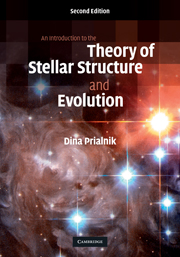Book contents
Summary
This chapter differs from previous ones by being descriptive rather than analytical. An account will be given of the evolution of stars as it emerges from full-scale numerical calculations – solutions of the set of equations (2.54), with accurate equations of state, opacity coefficients and nuclear reaction rates. Such numerical studies of stellar evolution date back to the early 1960s, when the first computer codes for this task were developed. The first to program the evolution of stellar models on an electronic computer were Brian Haselgrove and Hoyle in 1956. They adopted a method of direct numerical integration of the equations and fitting to outer boundary conditions. A much better suited numerical procedure for the two-boundary value nature of the stellar structure equations (essentially a relaxation method) was soon proposed by Louis Henyey; it is often referred to as the Henyey method and it has been adopted by most stellar-evolution codes to this day. Among the numerous calculations performed by many astrophysicists all over the world since the early 1960s, the lion's share belongs to Icko Iben Jr. The detailed results of such computations cannot always be anticipated on the basis of fundamental principles, and simple, intuitive explanations cannot always be offered. We must accept the fact that, being highly nonlinear, the evolution equations may be expected to have quite complicated solutions.
As the complete solutions of the evolution equations provide, in particular, the observable surface properties of stars, we shall focus in this chapter, more than we have previously done, on the comparison of theoretical results with observations.
Information
- Type
- Chapter
- Information
- An Introduction to the Theory of Stellar Structure and Evolution , pp. 144 - 188Publisher: Cambridge University PressPrint publication year: 2009
